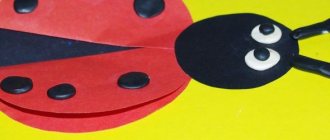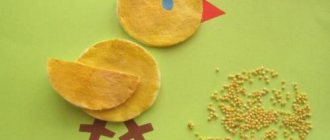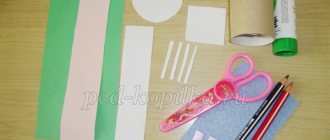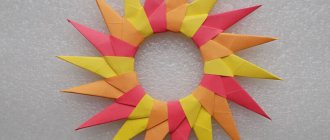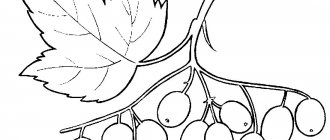For the successful all-round development of a child, activities to develop fine motor skills are of great importance. One of the types of such activities is applications made from colored paper, templates for which were developed by methodologists taking into account the characteristics of the age groups of preschoolers.
It is important that the complexity of the task corresponds to the age of the child, that classes are carried out systematically, gradually becoming more difficult, and are carried out under the supervision and assistance of adults.
What are the benefits of template applications for development?
Paper applications are a creative process through which children learn about the world around them and acquire many skills. In addition to the development of fine motor skills of the hands, this includes coordination of movements, the study of colors and their combinations, the concept of composition, familiarity with various materials and textures, the development of observation, imagination and fantasy.
Working on an application in a team promotes organization, restraint, and accuracy. It is also necessary to note the development of spatial imagination: when doing appliqué, children create a whole from several components and, conversely, learn to divide the whole into parts.
Scientists have proven that in the cerebral cortex, the center responsible for fine motor skills is located next to the speech center and contributes to the development of speech skills.
Simple applications for children 2-3 years old
Simple applications made from colored paper using templates can be practiced from the age of 2. However, some experts believe that children as young as 1 year can perform feasible tasks.
Initial lessons involve gluing pieces of paper onto a sheet in any form. At this stage, the child must understand and remember the basic actions: spread, turn over, apply, smooth. Kids are still attracted to the process itself; they will strive for the result later.
At the second level of complexity, templates are used. The child must place the elements also chaotically, but within the contour, and a certain image appears.
Application template from colored paper “Hedgehog”
A template is a schematic image of a future picture, drawn or printed on a printer. Simple templates for applications made from colored paper can include, for example, a Christmas tree with balls, a tree with apples, and others.
For such work, you need to prepare elements: balls, apples, etc. The child must determine for himself how to arrange them on the templates.
Palm tree applique template
Flower applique template
For small children, it will be interesting to perform a simple cut-out appliqué. The child watches the adult tear the paper into long strips, then tears them into shreds himself. These pieces need to fill the outline.
If the child wants to tear the paper himself, then these uneven, awkward strips can also be used to create an applique, for example, grass. Ants are drawn using finger paints.
Further, the task becomes more complicated: you need to hit the element on a specific place in the template or drawn outline. So, using cut out circles, an image of a caterpillar is created. At this stage, children are no longer interested only in the process, but also in the result.
When making appliqués from colored paper using templates and contours with children under 3 years of age, prepared cut out elements are used.
A three-year-old child can already be taught the skills of working with scissors with rounded ends.
At the same time, it is necessary to explain how to properly hold scissors and paper so as not to get hurt. You need to start with straight cuts, then work on bends and roundings.
At this age, children are already able to create simple plot pictures. Elements pasted onto the template allow you to create a specific image.
The background for the application can be a drawn outline with partially drawn elements. For example, children can populate a template aquarium with algae and stones at the bottom with inhabitants: fish, jellyfish, etc.
An interesting activity can be connecting and gluing a cut picture. If a child copes with such a task easily, it is recommended to complicate it: add raindrops to the umbrella, glue windows to the house with an attached roof. Such activities develop imagination, observation, and a sense of proportion.
Applications for children 4-5 years old
At this age, colored paper applications and templates for them become more complex. By preparing, together with an adult, elements for a future picture, the child shows more independence: cuts, selects colors and, thus, gains an understanding of composition.
This activity develops logical thinking and allows you to show creative inclinations.
For children 4-5 years old, a fun activity is making cards, which they then give to their parents and friends.
The base is folded in half and elements are glued inside the postcard to form a plot picture.
The templates developed by specialists are only examples indicating the direction of work.
Parents and educators can contribute their ideas. For example, using a cut out outline of a baby’s palm in an applique – such pictures evoke amazement and delight in children.
Applications with palm
The technique of appliqué using only circles reveals for the child the relationship between the parts and the whole.
When developing a child’s creative imagination, you should show him various techniques for working with paper: for example, folding it in the shape of an accordion. For such a picture you need to prepare a base and draw contours. The gluing process also becomes more complicated.
Making flower parts
It is necessary to cut out 3-5 stems and 6-10 leaves. We cut out droplet-shaped petals from multi-colored paper (there can be any number of them). Cut out 3-5 cores. If the child is already independent, you can offer him to cut out all the elements, the main thing is to draw an outline with a pencil.
First, glue the stems with leaves; one stem can have from 1 to 3 leaves. The flower arrangement can be decorated with a beautiful vase or basket; in this case, the leaf on the stem is glued last.
Then petals are glued on top of the stem in a circle (it will look beautiful if the first row has large petals, and with each circle there are fewer and fewer). At the end, the core of the flower is glued.
Inside the card, lines are marked with a pencil and the child is asked to write a wish.
The postcard is ready! You can safely give and enjoy the joy of your loved ones.
Complex applications for children 6-7 years old
Children of senior preschool and primary school age already have certain skills.
Practicing appliqué work from colored paper using templates during this period helps further develop fine motor skills, thinking, memory and concentration, and develops the ability to plan one’s activities.
An important circumstance is that the child foresees the final result of his work.
At this age, children develop the skill of cutting out individual parts and solid silhouettes, symmetrical elements from paper folded in half, as well as the ability to create compositions and correctly arrange their individual parts on a base.
At this stage, children study color combinations, analyze and compare details. The texture of the material also becomes varied: in addition to ordinary colored paper, creped (“crumpled”), streaked (glossy), textured (embossed or imitating velvet), and foil are used.
During this period, you can move on to volumetric symmetrical compositions.
To complete this task, templates (clouds, balloons) are cut out in the usual way. Next, two identical templates are folded in the center and fastened together (can be sewn). The prepared elements are glued to the base.
To make a three-dimensional bird, the template is folded in half and glued together, except for the wings, which are folded along the dotted line.
The resulting result can be pasted with one side and a wing onto the base (in the form of an applique) or turned into a craft by tying it to a thread and hanging it on a branch.
Having mastered the basics of composition at the previous stages, children aged 6-7 years are able to create entire paintings - landscapes, still lifes, using ready-made templates for appliqués from colored paper or making them with the help of a teacher or parents.
Adorable animals
The cute lion cub consists of a round head decorated with eyes, nose and mouth.
- The mane will be paper strips folded in half and located around the perimeter.
- Don't forget about the paws, which look like cone-shaped pieces.
- No less expressive is a white bear on a blue background of two circles - a muzzle and a body with four paws attached, walking through the Arctic expanses.
Easy options - pig, chicken, whale, owl, fox, cat. You can use fairy-tale scenes with a kolobok, an oak tree with a golden chain, and a little mermaid.
A colorful cockerel or firebird made from different types of buttons looks great. Parents will sketch these characters, and children will independently fill in their outlines as they wish.
Applications using a disposable plate
Disposable plates are a convenient material with which you can create original and beautiful compositions. Made of polystyrene or cardboard, of different colors, with different embossed patterns, they can be both the basis for an applique and elements for it.
You can involve children from a young age in making applications from colored paper on a disposable plate using templates. On a prepared colored background, children arrange simple elements in the form of a pattern.
A more complicated option is to use two or more colors for the background and more complex elements. Children 6-7 years old create thematic compositions on plates or use them as material for individual elements.
Examples of gradually more complex appliqués on plates:
Flat craft
To create a flat craft, you need to prepare the base and cut out elements. This is one of the simplest craft options that are suitable for preschool children.
You can choose any image of a flat craft, it can be animals, flowers, seasons and much more.
Combined applications
When making appliqués from colored paper, the patterns can be diversified by combining different materials.
Cereal applications
This type of application can be done even with small children. The algorithm of work is as follows: an adult applies glue to the prepared drawing, the child sprinkles cereal on it and lightly presses it with his finger.
The remaining grains that are not glued need to be shaken off. This activity instills attentiveness and accuracy in the child.
Older children can use different types of cereals. In this case, the glue is applied one by one to individual areas. To make the picture more colorful, it is recommended to first tint the cereal with gouache in different colors. You can use your child’s own drawing as a template; this will stimulate him and inspire him.
Button applications
To perform such an application, preliminary preparation is necessary. After studying the drawing and choosing colors, the child, with the help of adults, selects buttons that match the color and size. Then you should lay them out in a picture to visualize the desired result, and begin gluing.
For younger children who do not yet have the necessary skills, you can apply a drawing according to a template on a layer of plasticine - the child will attach the buttons by pressing. This technique is also applicable when working with cereals.
For combined applications, cotton wool, napkins, eggshells, natural materials - leaves, petals, seeds and much more are also used.
Multilayer applications
Multilayer (overlay) applications made of colored paper or other materials are made using templates designed or made independently.
This kind of work develops spatial imagination and cultivates aesthetic taste. They are made from paper, fabric, leather, felt - the main thing is that the edges of the material do not fray.
Multilayer applications, like other varieties, come in varying degrees of complexity. For little ones, this is a simple matter of gluing parts on top of each other. By fastening elements only on one edge, you can create a three-dimensional effect.
More complex appliqués have more details and require good scissor skills and a sense of proportion and color.
Older children, with developed fine motor skills and the skills to make complex parts, create real works of art - unusual compositions and even portraits. Light and shadow effects give them special color.
Multilayer appliqué is a truly creative process in which the child’s imagination and artistic abilities are revealed. It is necessary to think through the image, color scheme, and sequence of action, so this type of work requires a certain level of intelligence.
Ladybug
Let's try to display a bright insect in a convex manner.
Sequencing:
- We will need two red circles and a black semi-oval.
- We glue the spheres, bent in half, in places of the folds and mark the recognizable points of the insect on them.
- Let's add the head, antennae and eyes.
If we want to show a flying specimen, then the wings are attached to the body in a cut state on the sides.
Piece applications
Appliqués made from cut or torn pieces of colored paper using templates are quite simple and can be done even by small children. You need to apply a drawing to the base sheet. In addition to ready-made templates, you can use children's coloring books or come up with a sketch yourself.
The production of appliqué elements is carried out together with the child - small children happily tear the paper into pieces. If you already have skills in working with scissors, you can allow these elements to be cut out.
An important detail: the younger the child, the larger the fragments should be.
Having selected the desired colors, you can begin gluing.
The glue is applied not to small parts, but to the template, in sections. When working with children, this process is carried out by an adult; older children themselves apply the glue with a brush. When gluing pieces of paper, the child must accurately fall into the outline.
A type of applique made from pieces is trimming. This technique is quite complex, but children 6-7 years old are quite capable of it, especially when working in a group.
To master the cutting technique, teachers and parents are offered master classes on this topic.
Tools for work
Before you start creating masterpieces, you need to stock up on all the tools necessary for this work. All of them can be easily bought at the same office supply store, so there should be no problems with this.
To create a beautiful application you will need:
- regular or curly scissors;
- paper cutting knife;
- ruler (wooden or metal);
- figured hole punches;
- regular tape;
- PVA glue or glue stick;
- brush.
In addition to the basic tools, you can use other additional items to create an applique. These include pencils, felt-tip pens, beads, etc.
Autumn themed applications
The bright colors of autumn make it possible to create colorful pictures of autumn nature. For applications on this theme, both colored paper and natural materials are used: multi-colored leaves, petals of late flowers, seeds, spikelets, twigs and other objects.
When making autumn-themed applications from colored paper using templates and in a free composition, the main attributes are preserved - flowers, mushrooms, fruits, acorns, and tree silhouettes are cut out and painted. An obligatory component is autumn leaves.
When working with natural material, you need to prepare it. The collected leaves must first be leveled and dried under pressure. If the leaf needs to be given any shape, then a fresh leaf is used for this, which is then dried.
For collages and mosaic paintings, you can prepare cardboard templates onto which the elements are glued.
Autumn nature is fertile ground for the flight of children's imagination. Leaf applications placed in a photo frame will decorate any interior.
Autumn lanterns will also be a spectacular decoration. To do this, the outside of the glass vessel is covered with multi-colored leaves (paper or natural), and a small candle is placed inside.
Performance
Prepare an apple and leaf template. An adult can draw it himself on a sheet of cardboard or find a ready-made stencil on the Internet.
You need to take red or green paper and trace the outline according to the template. To make an apple you will need to circle and cut out 3 identical parts. For leaves, you need to repeat the steps.
Note!
DIY paper crafts the most interesting: simple origami instructions + master class on creating creative crafts with your own hands (130 photos)
Paper sword - TOP-120 photos of creative solutions for creating a paper sword + simple instructions and diagrams for children
DIY paper crafts - simple patterns for creating paper crafts step by step + original ideas for beginners with photo reviews
Fold each piece vertically in half. If the colored paper is one-sided, then you need to fold it inward with the colored side.
In order to get a voluminous apple, all halves need to be glued together by lubricating them with glue.
Additionally, you can cut out a twig; there is no need for a stencil here; this can be done arbitrarily.
Collect the entire composition. Take a sheet of cardboard, first glue a twig, then apples, and finally glue a twig.
A wonderful three-dimensional picture is finished. Now you can hang it in a prominent place and admire your child’s creativity.
Winter themed applications
To create winter and, in particular, New Year's applications, any of the described techniques is used, depending on the age of the children.
The most common type of winter applique is snowflakes - this is a subtype of silhouette type applique. It is recommended to fold the sheet correctly, trim the edge and sharp corner, and make cuts on plain paper first - this is how the skill is developed.
In addition, pendants made of such snowflakes decorate the room. Thin, airy snowflakes can be glued to windows and other surfaces.
For small children, it is better to prepare templates (circles with an outline) and make a broken snowflake from pieces. For flat, voluminous, multi-layer snowflakes, you need to prepare patterns for cutting.
To make a traditional Christmas tree, kids use triangles from green paper, a snowman is made from white circles, and a teacher or parent helps add details to the applique.
Older children can be asked to make a Christmas tree from strips of paper or create a picture of a winter forest using templates using small pieces of paper or cotton wool.
A Christmas tree made of paper balls looks bright and voluminous. For this purpose, a template and elements are made from crepe paper. The main color is dark green; multi-colored balls are made for the garland.
After applying glue to the template, it is recommended to first position the garland, then fill the outline with “needles” and complete the applique with a star and base.
An interesting applique depicting winter accessories allows children to show their creative imagination.
The hat and mittens can be decorated with any ornament, animal figures, winter pictures, beads or rhinestones.
Cotton wool is used to imitate fur.
Using a disposable plate, you can make a polar bear mask craft. Holes are cut out in the plate for eyes, the surface is covered with pieces of paper, and a disposable cup is used for the nose.
Senior preschoolers and elementary school students are able, under the guidance of adults, to create complex winter landscapes using mixed techniques.
Holiday cards
It is customary to give such congratulations and wishes to relatives on holidays.
- On March 8, children can present mothers and grandmothers with a copy of spectacular mimosa, violets, and poppies. It is not difficult to reproduce the appearance of daisies whose petals are made from paper ribbons. If you twist corrugated paper around a thin wire, fixing the edges with glue, you get bendable, thick “sausages”, from which various flowers are folded.
- The boys will be happy to assemble cars, boats, rockets and give them to dad on February 23rd. For the New Year they depict a Christmas tree, a mitten, a snowman or a bunny. The verisimilitude of a winter landscape is achieved with ordinary cotton wool or cotton pads; they are used entirely or cut as needed.
Beautiful types and techniques of appliqués are complemented by quilling, which can be used to recreate a delightful heart. Having twisted the sheet into a roll, it is cut into centimeter sections; these paper curls, reminiscent of roses, are laid out on a cardboard base.
Spring themed applications
Snowdrops and lilies of the valley, starlings and flowering trees - these signs of spring are traditionally used in children's applications made from colored paper using templates. The little ones perform simple tasks, placing prepared elements on the contours. These same images can be complicated by adding pictures of spring nature.
More complex compositions - voluminous, multi-layered, with a large number of elements - are created by children who have the skills to work with glue, scissors, a brush and use different techniques.
Lilacs in a vase made of cereals, a spring picture using drawing and appliqué techniques - these and many other ideas are offered by experts to parents and educators for educational activities with children.
Applique is a visual activity. Having achieved the desired result, the child experiences aesthetic pleasure, thereby joining the world of beauty, the world of art. A simple and accessible way for children to create artwork makes appliqué one of the favorite types of educational activities for children.
